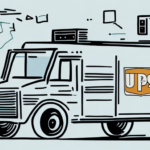Understanding the Large Package Surcharge for UPS Shipping
If you are a business owner that regularly ships products with UPS, you may have come across the term "large package surcharge." This additional fee is added to shipments that exceed specific size and weight restrictions set by UPS. In this article, we provide a comprehensive guide to understanding the large package surcharge for UPS shipping.
What is a Large Package Surcharge and How Does it Affect Your Shipping Costs?
A large package surcharge is an additional fee charged by UPS to shipments that exceed specific size and weight restrictions. Generally, any package that weighs more than 150 pounds or exceeds 165 inches in combined length and girth (length + 2x width + 2x height) is considered oversized and subject to the surcharge.
The large package surcharge can significantly impact your shipping costs, especially if you are shipping large, bulky items. Depending on the size and weight of your package, the surcharge can range from $100 to $650 per package, in addition to regular shipping fees. This can quickly add up, resulting in higher shipping costs for your business.
It's important to note that the large package surcharge is not the only additional fee that may be applied to your shipment. Other fees, such as residential delivery fees or fuel surcharges, may also increase your shipping costs. Carefully reviewing your shipping options and associated fees before selecting a carrier and shipping method is crucial.
One way to avoid the large package surcharge is to break up your shipment into smaller, lighter packages. While this may require more time and effort, it can ultimately save you money on shipping costs. Additionally, consider alternative shipping methods, such as freight shipping or LTL (less-than-truckload) shipping, which may offer more cost-effective options for larger, heavier items.
The History of UPS's Large Package Surcharge
The large package surcharge was first introduced by UPS in 2006 as a way to mitigate the cost of handling and delivering oversized packages. At the time, UPS was struggling to keep up with the growing demand for e-commerce shipping, and the additional fee was seen as a necessary measure to maintain profitability.
Since its introduction, UPS has adjusted the size and weight restrictions for the surcharge several times to reflect the changing shipping needs of businesses and customers.
In 2018, UPS announced the implementation of peak surcharges during the holiday season to manage the surge in package volume. This meant that, in addition to the large package surcharge, customers would also have to pay extra fees for packages shipped during the busiest time of the year.
However, in response to the COVID-19 pandemic and the resulting increase in online shopping, UPS temporarily suspended peak surcharges in 2020 to support businesses and consumers during a challenging time.
Factors That Contribute to the Large Package Surcharge
The large package surcharge is determined by a combination of factors, including package size, weight, and destination. The larger and heavier the package, the more it will cost to ship. Additionally, packages shipped to distant or hard-to-reach destinations may incur higher fees due to the extra effort required for delivery.
Packaging and Shipping Method
Other factors contributing to the surcharge include the type of packaging used and the chosen shipping method. For instance, using an unnecessarily large box or selecting a slower shipping method can result in higher fees.
Package Fragility
The fragility of the package also plays a role. Packages containing fragile items that require special handling or packaging may incur additional fees, as extra care is needed to ensure the items arrive intact.
Seasonal Demand
The time of year can affect the surcharge as well. During peak shipping seasons, such as the holidays, carriers may impose additional fees to account for the increased volume of packages being shipped.
How to Avoid the Large Package Surcharge When Shipping with UPS
To avoid the large package surcharge when shipping with UPS, consider the following strategies:
- Keep your packages within the size and weight restrictions set by UPS.
- Use appropriate packaging that does not add unnecessary weight or size to your shipments.
- Choose a shipping method that aligns with the size, weight, and destination of your package.
- Consider using a freight carrier for larger shipments, as they often have different size and weight restrictions than traditional package carriers.
Remember, the large package surcharge is not the only additional fee UPS may charge. Other fees, such as residential delivery surcharges, fuel surcharges, and additional handling fees for packages requiring special attention, may apply. To avoid unexpected fees, carefully review UPS's fee schedule and shipping policies before sending your package.
The Impact of Dimensional Weight on the Large Package Surcharge
Dimensional weight, also known as volumetric weight, is a calculation used by shipping companies to determine the cost of shipping packages that are lightweight but take up a lot of space. To calculate the dimensional weight, the carrier measures a package's length, width, and height and uses a specific formula to determine its cubic size.
If the dimensional weight of a package is higher than its actual weight, the carrier will charge based on the dimensional weight rather than the actual weight. This can result in significantly higher shipping costs, especially for large, bulky items that occupy a lot of space but weigh very little.
Many shipping companies, including UPS, apply a large package surcharge to packages that exceed certain size or weight limits. This surcharge is in addition to regular shipping fees and can accumulate quickly for businesses that frequently ship large items. The dimensional weight of a package can often push it into the large package category, leading to even higher shipping costs. To avoid these surcharges, businesses may need to explore alternative shipping methods or packaging options that reduce the size and weight of their packages.
Calculating the Cost of a Large Package Surcharge for Your Business
To calculate the cost of the large package surcharge for your business, use UPS's online calculators to estimate the fees based on your package's size and weight. Keep in mind that surcharge costs may vary depending on the shipping destination, type of packaging, and chosen shipping method.
The large package surcharge typically applies to packages exceeding the maximum size and weight limits set by UPS. If your package falls within these limits, you may not be subject to the surcharge. To avoid unexpected fees, accurately measure and weigh your package before shipping.
Additionally, some businesses may be eligible for discounts or waivers on large package surcharges, depending on their shipping volume and agreements with UPS. Exploring these options can help you save on shipping costs for your business.
Comparing UPS's Large Package Surcharge to Other Shipping Carriers
While UPS's large package surcharge may seem high, it's important to note that other shipping carriers also have size and weight restrictions that can lead to additional fees. For example, FedEx's oversized package fee is $80 per package, while USPS charges an additional $100 for packages exceeding their size limits.
When choosing a shipping carrier, compare all shipping costs, including additional fees and surcharges, to determine which carrier offers the best overall value for your business.
Consider the delivery timeframes offered by each carrier as well. While UPS may have higher fees for large packages, they often provide faster delivery times compared to other carriers. Additionally, UPS offers a wider range of delivery options, including same-day and weekend delivery, which can be beneficial for businesses with time-sensitive shipments.
Tips for Negotiating Lower Large Package Surcharges with UPS
If you regularly ship large or oversized packages with UPS and are concerned about surcharge costs, consider the following steps to negotiate lower fees:
- Sign a contract with UPS that includes negotiated rates and discounts tailored to your specific shipping needs.
- Optimize your packaging to reduce the size and weight of your shipments.
- Select a shipping method that is appropriate for the size, weight, and destination of your package.
- Use a freight carrier for larger shipments, as they may offer different rates and restrictions than traditional package carriers.
Another effective strategy is to consolidate your shipments. If you have multiple packages going to the same destination, consider combining them into one larger shipment. This can help you avoid multiple surcharges and potentially qualify for lower rates. Additionally, negotiate directly with UPS to see if they are willing to waive or reduce the surcharge for your business.
Common Misconceptions About the Large Package Surcharge and UPS Shipping Costs
There are several common misconceptions about the large package surcharge and UPS shipping costs in general:
- Myth: The large package surcharge is a scam designed to make businesses pay more for shipping.
- Fact: The large package surcharge is a legitimate fee charged by UPS to cover the extra costs associated with handling and delivering oversized packages.
- Myth: UPS's shipping costs are always higher than other carriers.
- Fact: UPS's shipping costs may be higher or lower than other carriers depending on the size, weight, destination of your shipments, and your specific shipping needs.
Another common misconception is that UPS only offers expensive shipping options. In reality, UPS provides a range of shipping options to fit different budgets and delivery needs. For example, UPS Ground is a cost-effective option for non-urgent shipments, while UPS Next Day Air is a more expensive but faster option for urgent deliveries. Exploring all of UPS's shipping options can help you find the one that best fits your needs and budget.
Conclusion
Understanding the large package surcharge for UPS shipping is essential for managing your business's shipping costs effectively. By keeping your packages within size and weight restrictions, using appropriate packaging and shipping methods, and negotiating lower fees when possible, you can minimize the surcharge's impact on your bottom line. Staying informed and making strategic shipping decisions will help ensure that your business remains competitive and profitable in today's fast-paced e-commerce environment.




















